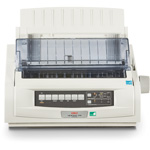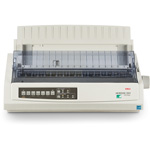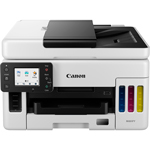OKI Dot Matrix Printers – Microline Series
For more than four decades, OKI have perfected the technology behind the Microline series of Dot Matrix printers – ensuring they are reliable, versatile and easy to operate. The models in the extensive series benefit from different capabilities and features, all offering low cost-per-copy printing.
One of the major benefits of Dot Matrix printing is the impact technology which allows the printers to produce several copies simultaneously when used with multipart carbon copy paper.
Almost half a century after OKI first introduced the technology, Dot Matrix printers are still ideal for use as point of sales (POS) printers or as no-frills workhorses.
The Technology Behind Dot Matrix Printers
Dot Matrix printers create text and graphics by transferring a pattern of dots from an ink-soaked cloth ribbon against a sheet of paper. Using impact technology, tiny metal pins strike the cloth ribbon in the pattern dictated by the person printing. The pins are arranged in columns and propelled forward with an electromagnet or a spring.
The column of pins is contained in a print head, mounted on a carriage which moves back and forth over the width of a sheet of paper, powered by a gear-linked digital stepper motor called the Line Feed Motor. As the print head moves across the sheets of paper, the pins are propelled forward to produce a page of print.
OKI’s heavy duty Dot Matrix printers benefit from a precision belt which allows heavy duty drive motors to be used whilst reducing overall carriage weight and inertia.
The words are produced one letter at a time, and pages are printed one letter at a time. OKI’s Dot Matrix printers are capable of bidirectional Printing (printing in both directions) which accommodates faster output. However, many models in the OKI range can be set to unidirectional mode for improved graphics quality.
The Print Heads
OKI Dot Matrix printers utilise two different types of print heads to produce the text and graphics: classic and permanent magnet.
Classic Print Head
The classic (sometimes referred to as the ‘clapper’) print head system utilises an electromagnetic field which shoots pins forward, striking the ribbon against the paper. This print head is featured on the OKI ML1120 and ML1190 entry level Dot Matrix printers.
Permanent Magnet
All other Dot Matrix printers from OKI have been fitted with permanent magnet print systems to guarantee quality, reliability and performance. The system operates using spring-loaded pins which are held under tension by a permanent magnet and released by a small passing current to strike the ribbon against a sheet of paper.
Permanent magnet print heads are traditionally faster but more expensive to manufacture.
Dot Matrix print heads are protected and maintained by a small, hard-wearing guide plate known as the jewel which is mounted at the front of the system. This helps to maintain an accurate and straight alignment of pins – helping provided a long life for the print head.
Pins and Print Quality
Dot Matrix printers are available in 9, 18 and 24 pin varieties – each offering their own benefits.
The 9 pin printers offer the optimum mix of speed and quality printer performance, capable of producing Near Letter Quality (NLQ) output. These printers are most commonly used for drafts, financial information and data listings.
The 18 pin printers in the OKI range comprise of 2x9 print heads to share the load and offer incredibly speedy printing. This technology is featured on the heavy-duty OKI Dl4410 printer.
Finally, 24 pin printers contain pins of a small diameter which are arranged in interleaved columns. Providing superior quality, the 23 pin printers are capable of producing Letter Quality (LQ) output.
OKI Internal Fonts
OKI Dot Matrix printers include a selection of internal fonts, helping to improve the appearance and presentation of documents. The fonts are a combination of typeface, spacing, size and pitches (character width).
The height of the characters is measured in points, and each point is approximately 1/72 of an inch. The pitch refers to how many characters can fit in an inch by width. Some fonts incorporate fixed pitch – where every character has the same width, making alignment very simple. Common pitch values include 10, 12, 15, 17.1 and 20cpi (characters per inch).
Fonts with different character widths are called proportional fonts – these are included as standard in many OKI Dot Matrix printers.
Additional Fonts
True type fonts (MS Windows fonts) can also be created using an OKI Dot Matrix printer, but these will be printed as a graphic image which can slow down the print output significantly.
Line Spacing
Line spacing down the page is measured in lines-per-inch (lpi). The most commonly used line spacing is 6lpi.
Column Width
Dot Matrix printers are traditionally classified by the number of columns they print or the width of the paper they can accommodate. There are two main classifications: wide carriage (136 columns) and narrow carriage (80 columns)
Wide Carriage
Wide carriage Dot Matrix printers can print a maximum of 136 characters per line at 10cpi – producing 136 columns. The wide carriage printing necessitates paper which has a width of 14 inches, slightly smaller than A3 paper.
Narrow Carriage
The narrow carriage Dot Matrix printers can print a maximum of 80 characters per line at 10cpi – producing 80 columns. This necessitates paper which is 8.5 inches wide, roughly A4 paper.
Print Speeds
Rather than pages per minute (ppm), the speed of Dot Matrix printers is measured in characters per second (cps). A 400cps machine will take approximately 30 seconds to produce a page. The OKI range of Dot Matrix printers includes entry level models with 300cps print speeds as well as comprehensive heavy duty workhorse printers capable of speeds over 1,000cps.
The print speeds are the maximum speeds and should be used only as a point of comparison – with a number of external factors also affecting output. Font, print quality and head gap settings all affect actual print speeds.
Advanced Long-Term Reliability
Every aspect of each model in the OKI Dot Matrix printer range has been carefully designed to provide complete reliability and robust performance in all environments. The polycarbonate plastic casings are tough, chemical resistant and rigid – so they are perfect for the shop floor and laboratory alike.
Mean Time Before Failure
Using the mean time before failure (MTBF) calculation based on printing at 35% page density at 25% duty for 8 hours/day, 20 days/month and 12 months/year (1,920 power-on hours per year), an OKI printer with 20,000 hours MTBF will provide over a decade of error-free usage.
Simple Installation and Use
Despite the wide range of features and comprehensive output, the Dot Matrix printers from OKI have been designed to be incredible quick and simple to set-up, and efficient to use. After the quick installation, users can choose from a number of interfaces to enhance system compatibility.
The printers in the Dot Matrix range are compatible with a wide range of different software packages thanks the built-in emulations (the language used by the printer to communicate). The easy to follow navigation systems and control panels further simplify the printing journey.
Low Cost Printing
Dot Matrix printers have long been the choice of workplaces looking to cut running costs and overheads. The long MTBF and inexpensive replacement fabric ribbons ensure minimal running costs are necessitated throughout the life of a Dot Matrix printer.
Authentic OKI ribbons are the only replacement ribbons which can ensure best print quality, performance and robust reliability. Off-brand replacements could compromise the performance of the printer and lead to potential jamming and seized print heads.
Versatile Paper Handling and Performance
Many of the models in the OKI Dot Matrix printer range include a variety of paper handling and feeding methods, accommodating top, rear, bottom and front paper paths. Top and front paper paths (sometimes referred to as Friction Feed) can accommodate the feeding of envelopes and cut sheet paper as well as feeding continuous roll paper. This is best-exemplified in the ML6300FB-SC which features error-free friction feeding and automatic skew correction.
Every model in the range incorporates a push Tractor Feed (usually in the rear paper path) which enables the use of continuous paper and labels. A tear bar is provided to separate printed pages and distributed. Push tractors provide the best method for printing one or two page-long documents such as invoices. OKI Dot Matrix printers further simplify this process with the inclusion of the automatic tear-off feature.
Advanced Paper Handling
The OKI Dot Matrix printers incorporate a number of features and controls to simplify the paper-handling process including:
- Top of Form (TOF) – Accommodating precise alignments and position of paper
- Tear – Automatically retracing continuous prints to the correct print position for easy tear support
- Park – Automatically retracts and parks paper to accommodate different paper paths
Heavy Paper and Label Printing
The bottom feed has been designed to help accommodate the printing of heavy paper and labels – offering the flattest paper path which reduces the risk of labels peeling away from their backing.
Roll Paper Stand
Additional roll paper stands can help support continuous prints of call logs and data sheets. A vast array of OKI Dot Matrix printers can be fitted with this technology to support the printing of receipts, invoices and more. A number of paper types can be used in a roll paper stand – providing a more versatile service.
Adjusting the Print Heads
OKI Dot Matrix printers also benefit from the inclusion of adjustable print heads, accommodating paper of different thicknesses. Preventing paper from getting stuck and smudging, print head adjustment can support a variety of different tasks. It is important to ensure the print head is adjusted to the right height for the job at hand.
When the print head gap is increased, print speeds will be slowed down to maintain print quality.
Environmentally-Friendly Printing
The OKI team has invested significant time and resources to ensure their Dot Matrix printers are environmentally-friendly, significantly reducing the machines’ footprints. The robust and reliable design, accommodating long MTBFs, helps to minimise waste and replacement costs. Productivity is seldom compromised due to OKI Dot Matrix printer failures.
Long Life Cycles
Whilst some printers seem to be rendered redundant within one year of use with new technologies – the OKI Dot Matrix range have been designed to stand the test of time. The OKI ML320 has remained enduringly popular more than 20 years. This makes them a reliable and cost-effective solution for businesses – completing the core of print responsibilities.
Low Cost Paper
Dot Matrix printers are capable of printing on low cost, low weight and recycled papers without compromising print quality. This can lead to significant savings for businesses which consume a lot of paper, reducing running costs.
Ribbons
The only consumable involved in Dot Matrix printing technology is the long-life ribbon. These inexpensive fabric ribbons can be replaced in a quick and mess-free manner.
Additionally, the small and lightweight ribbons can help minimise the costs of transport and replacement.
Energy Star-Recognised
All of the printers in the OKI Dot Matrix collection have been awarded the Energy Star in recognition of the energy-efficient designs and operation. Using less energy to perform to a high standard – OKI’s Dot Matrix printers are environmentally-friendly and more inexpensive to run.
CarbonZero
Helping to reduce impact upon the environment; OKI’s three main production facilities in Thailand, China and Japan have been made CarbonZero. OKI have demonstrated a dedication to reducing the company’s total greenhouse gas emissions, in line with United Nations objectives.
Energy Efficient
The streamlined performance of the OKI Dot Matrix provides energy efficient performance. Requiring minimal power during printing, the printers are well-suited to users looking to cut their overheads.
The Eco Range
Ideal for users looking to further decrease their energy consumption, OKI have redesigned and re-manufactured a number of their popular Dot Matrix printers to incorporate eco-friendly features. Keeping power consumption and overheads to a minimum, these printers are signified with the word ‘eco’ in the product name/description.
Amongst the power-saving features included in these products is a low-power sleep mode – ideal for cutting costs during periods of inactivity.
Important, Professional Printing
Designed for users who require consistent, reliable printing; the OKI Dot Matrix printers are found all around the world supporting mission critical printing from the factory floor to the point of sale. The versatility and reliability of the OKI printers have made them a popular choice in airports, car hire outlets, hotels, restaurants and more.
The capability to print several copies of a document simultaneously and on a range of paper types can help streamline print tasks and professional processes. The limited number of consumables ensures that replacement processes are simple and infrequent.
OKI Dot Matrix Printer Uses:
- Listings
- Reports
- Spreadsheets
- Pre-Printed Multipart Forms
- Delivery Notes
- Control System Logs
- Index Cards
- Shipping Documents
- Receipts
- Cheques
- Address Labels
- Barcode Labels
- Purchase Orders
- Picking Lists
- Invoices
- Dispatch Notes
OKI Dot Matrix Printer Locations
- Airports
- Factory Floors
- Air Traffic Control Centres
- Government Offices
- Builders Merchants
- Customer Service Desks
- Paper Mills
- Iron Foundries
OKI’s reputation for performance, versatility and reliability have led to the printers becoming the worldwide ‘invisible’ printer helping all industries complete a wide range of print tasks effectively, efficiently and accurately.
The comprehensive range of printers in OKI’s Dot Matrix range ensures there is a model which is perfect for your specific requirements. Let Printerland find the perfect OKI Dot Matrix printer for your needs:












